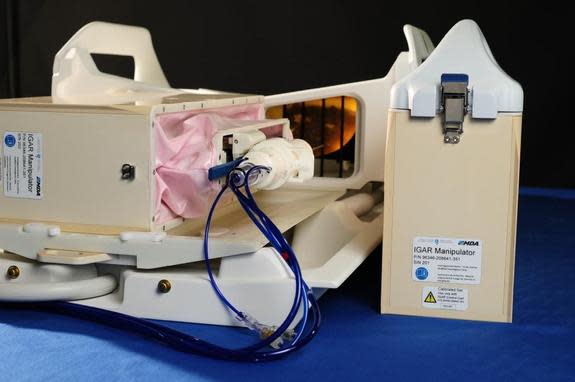
The same technology designed for huge robotic arms that help astronauts in space is being brought back to Earth to do some heavy lifting in cancer treatment — in the form of a surgical robot. Its inventors say the robot could take breast biopsies with remarkable precision and consistency.
The new machine is called IGAR, which is short for Image-Guided Autonomous Robot. NASA officials say it descends from a long line of robotic arms built for the Canadian Space Agency, such as Canadarm, which helped build the space station, service satellites and sometimes gave astronauts a lift during spacewalks, and Dextre, a maintenance robot on the space station. (This specific tech was developed by the British Columbia-based aerospace and communications firm MacDonald, Dettwiler and Associates Ltd.)
IGAR works in combination with a magnetic resonance imaging (MRI) scanner that can help doctors see potentially harmful mass in the breast. Currently, MRI is used to examine areas of the breast found on mammograms to be suspicious. With special software, a radiologist could tell IGAR which area to target with a needle-based biopsy device, or similar tissue-removing tool. [6 Foods That May Affect Breast Cancer Risk]
The space-inspired robot works with enough precision to insert the needle within about 0.3 inches (8 millimeters), of the suspicious lesion with a high degree of accuracy, said Dr. Mehran Anvari, chief executive officer and scientific director at Canada’s Centre for Surgical Invention and Innovation.
Anvari said IGAR will improve sampling, reduce the pain of the procedure, save time and, as a result, save money.
“It also will allow all radiologists to perform this procedure equally well, regardless of the number of cases per year and move the site of treatment from operation room to radiology suite for a significant number of patients,” Anvari explained in a statement from NASA.
Dr. Nathalie Duchesne, a breast radiologist at the Hospital Saint-Sacrement in Quebec City, will be performing the first of three clinical trials with IGAR. She, too, said she believes the surgical robot will make breast biopsies more consistent across different doctors, patients and types of lesions.
I’ve been teaching MRI-guided breast biopsy for years and there are many steps in the procedure that are operator-dependent,” Duchesne said in a statement. “These steps may prevent good sampling of the lesions if it’s not done properly. I believe IGAR will take care of this. It will subsequently decrease the time of the exam, ensure good sampling and increase patient’s comfort during the exam.”
NASA officials say IGAR could also be used to assist doctors in lumpectomies, a surgery that removes only the tumor and part of the surrounding breast tissues, as opposed to a mastectomy, in which the breast is removed. Some tumors might require a lumpectomy because they cannot be detected with ultrasound and X-ray mammography. Researchers say IGAR could be used deploy a tiny radioactive seed near the area of interest during a biopsy, which could later located with a detector, allowing the doctor to identify and remove the lesion.
The National Cancer Institute estimates that 232,340 American women and 2,240 men will be diagnosed with breast cancer in 2013, and that about 39,620 women and 410 men will die of the disease this year.
Source: Yahoo News



